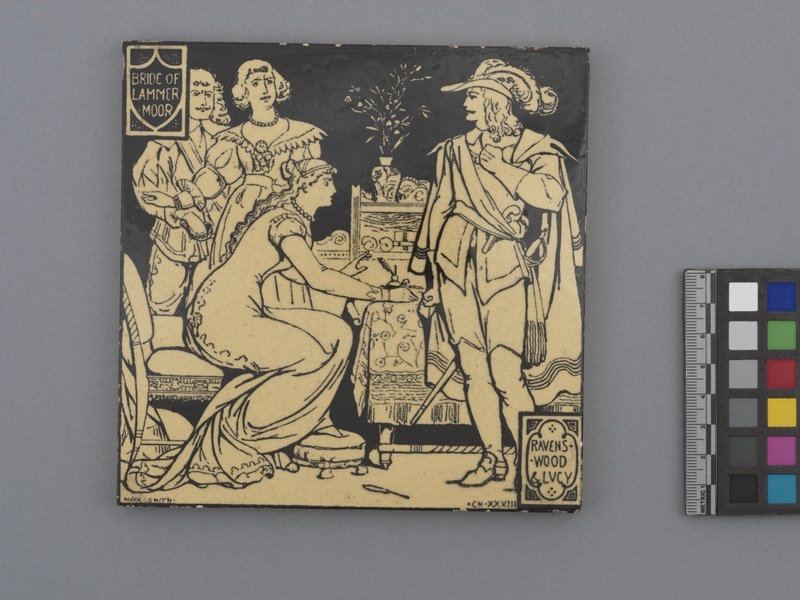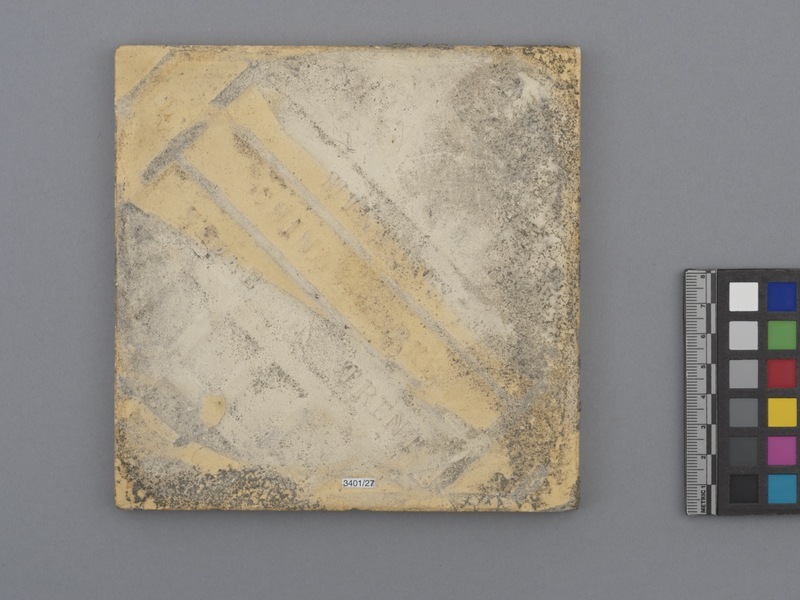Tile Item Number: 3401/27 from the MOA: University of British Columbia


Description
Square ceramic tile with scene painted on front. All sides are glazed. Background is black and all other design components are done in cream. Central design of three figures standing around a seated woman in an ornately decorated room. The woman, wearing a long short-sleeved gown, is at a writing desk, facing a man with a feathered hat and cape. In the background, to the left of the woman, are another man and woman. The standing woman is holding the second man back. In the top left corner, in a rectangle with a shield outline inside of it, are the words “Bride of Lammermoor.” In the bottom right corner, in a rectangle with a stylized oval inside of it, are the words “Ravenswood & Lucy.” The name of the tile designer is painted in the bottom left corner. Raised grid across back of tile. In centre of grid three diagonal ridges are stamped. Manufacturer’s mark, Mintons China Works, in between ridges.
Iconographic Meaning
The tile depicts a scene from ‘The Bride of Lammermoor: A Legend of Montrose” by Sir Walter Scott, first published in 1819. It was a popular novel, about doomed lovers set in seventeenth century Scotland. Chapter XXXIII is portrayed here, when Edgar, Master of Ravenwood (man on the right), confronts Lucy Ashton, his love (woman sitting), and her family in a tense situation to discover if she is engaged to another man. Edgar breaks off the secret engagement with Lucy after confirming her handwriting on the engagement papers to Bucklaw, as he believes that to be her wish. The woman in the back is presumably Lady Ashton, the villain of the story, who conspires against Edgar and is controlling of Lucy. Tile was designed by Moyr Smith, whose name is printed on the bottom left corner.
Specific Techniques
Tile was manufactured by dust-pressing, a technique that uses clay milled to a fine powder with low moisture content, then pressed in a die at high pressure. The design was transfer printed, a technique in which an image from an engraved plate is transferred to a tile, usually, requiring transfer paper to be run through a printing press with the engraved plate to pick up the ink, the design from the transfer paper could then be rubbed onto the tile.
Cultural Context
Wall tile. Mintons China Works.
Item History
- Made by Mintons (Manufacturer) and John Moyr Smith (Maker) in United Kingdom and Stoke-on-Trent, Staffordshire, England between 1860 and 1900
- Owned by Judith Stoffman before October 30, 2019
- Received from Judith Stoffman (Donor) on October 30, 2019
What
- Name
- Tile
- Identification Number
- 3401/27
- Type of Item
- tile
- Material
- clay, paint and glaze
- Manufacturing Technique
- dust-pressed and transfer-printed
- Overall
- height 15.5 cm, width 15.5 cm, depth 1.3 cm
Who
- Culture
- English
- Creator
- Mintons (Manufacturer) and John Moyr Smith (Maker)
- Previous Owner
- Judith Stoffman
- Received from
- Judith Stoffman (Donor)
Where
- Holding Institution
- MOA: University of British Columbia
- Made in
- United Kingdom and Stoke-on-Trent, Staffordshire, England
When
- Creation Date
- between 1860 and 1900
- Ownership Date
- before October 30, 2019
- Acquisition Date
- on October 30, 2019
Other
- Item Classes
- ceramics
- Condition
- good
- Accession Number
- 3401/0027